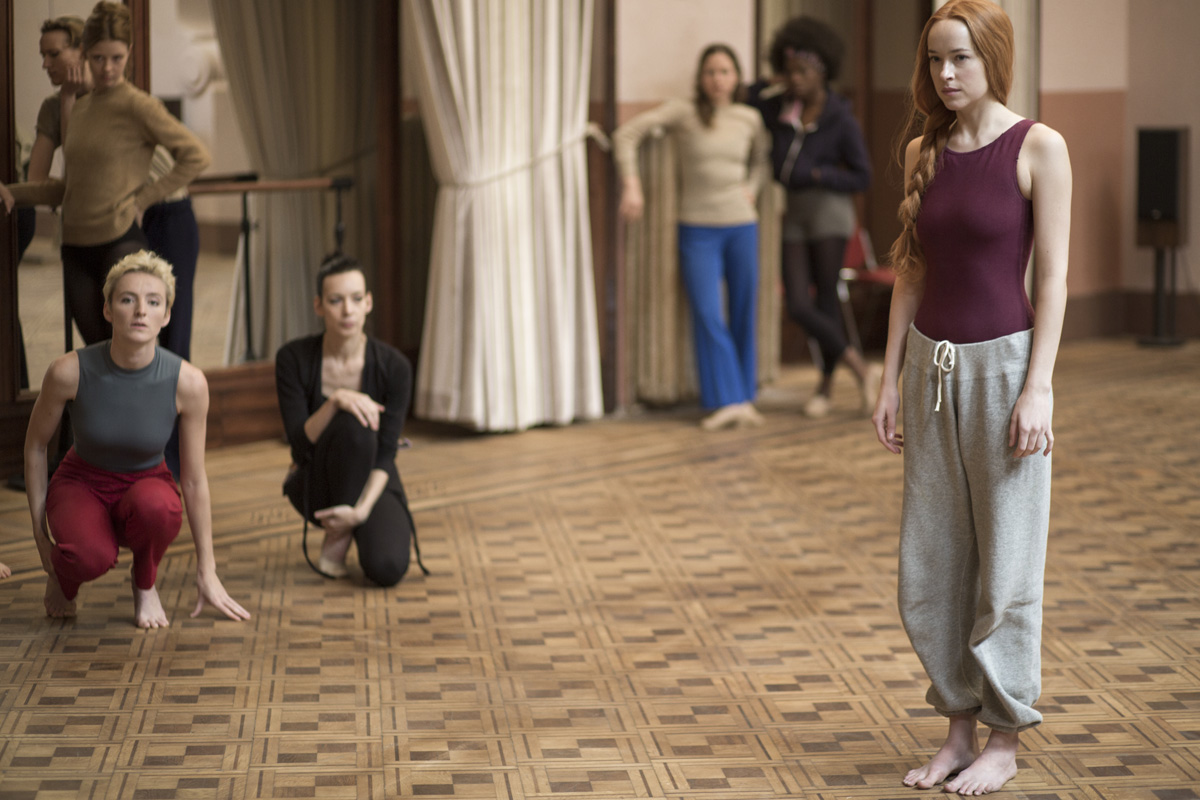
Photo: Sandro Kopp/Amazon Studios
Dario Argento’s 1977 film Suspiria has haunted and mystified audiences for decades, partly because of its radiant, psychedelic energy and decadently stylized violence; it seems less like a movie and more like a vibrant objet d’art. It stands out among Argento’s already fabulous oeuvre, so much so that the idea of a remake seemed like some sort of cinematic blasphemy when it was announced in early 2008. Still, Call Me By Your Name director Luca Guadagnino created an even more stylized, artistic and tonally different remake that stays consistent with the original’s main narrative while adding much more backstory and character development.
But this compelling new version suffers from too much information and story, giving away all details, subtext and answers, removing it of its enigma and mystery. And the mystery is a major part of what makes the original Suspiria so deliriously wonderful; it follows its own unwieldy dream logic without feeling the need to tie up the answers in a neat bow. It’s surprising for an art movie to be so revealing instead of letting the audience do some of the work, and frankly, it prevents me from completely embracing it.
Guadagnino’s Suspiria takes place in 1977 Berlin, where a distressed and paranoid young American woman named Patricia Hingle (Chloë Grace Moretz) bursts through her therapist’s office, schizophrenically babbling about the coven of witches who run the Helena Markos Dance Academy where she studies. Despite her clearly distraught and unhinged state, Dr. Josef Klemperer (played by Tilda Swinton in old-man prosthetics) remains skeptical, but it isn’t until Patricia disappears and leaves her notebook with hand-scribbled details about the coven that he begins to investigate.
Meanwhile, Susie Bannion (a Gothic, red-headed Dakota Johnson) leaves her dying mother and Mennonite lifestyle behind in Ohio to attend the prestigious Helena Markos Dance Academy. She shows up unannounced and begs for an audition, and since Patricia is formally missing, her absence leaves a spot open for Susie to join. Susie’s incredible natural talent wins her placement in the school, and soon she earns the lead in the upcoming recital, Volk, as well as favoritism with the school’s lead instructor, Madame Blanc (Swinton again, here looking like a Pina Bausch-lite).
The knowledge of the school’s witchcraft activities is obvious to the audience from the beginning but only dubiously suspected by its students, among them Olga (Elena Fokina) and Sara (Mia Goth). Susie seems preternaturally unfazed by any of the supernatural goings-on around her, and her matrons begin to prime her as the key to securing their headmistress Markos’ legacy. Unexpectedly, for everyone involved, Susie is more qualified and up for the role than they think.
Divided into six chapters plus an epilogue, Guadagnino’s Suspiria is extremely more muted from the visual style to the score, which is splendidly written by Radiohead’s Thom Yorke. The director makes sure the paranoia and dread are palpable, from the aggressive, jolting camera zoom-ins and jump cuts to the ongoing references and newsreel footage to the political turmoil du jour brought on by the Baader-Meinhof group. This Suspiria aims to reflect the zeitgeist of 1970s Germany still reeling from the trauma of the Holocaust—a very clear display of a Rainer Werner Fassbinder influence, but it doesn’t add much to the story at hand.
Some things I did appreciate: a more direct link drawn between dance and witchcraft, both of which bring connections between spiritual and carnal energies. This link is stunningly displayed in the violent death scenes that collect the more unfortunate characters, and while not as bloody or ostentatious as Argento’s, they are still elegantly shot and stylized.
While Susie’s friend Sara has more to do than in the original, Dr. Klemperer frustratingly gets more screen time and backstory than he deserves, which helps to bloat the film’s running time to 152 minutes. That said, I can’t deny the amazing acting job Swinton delivers (what can’t she do?). Johnson, speaking with the breathy naivete of her Fifty Shades of Grey character, is unexpectedly perfect for the role of Susie.
There’s a lot to admire about Guadagnino’s version of Suspiria, which he wrote with David Kajganich. Hell, even original star Jessica Harper, who has a cameo in this one, gives it her seal of approval. But depending on how you view the original film, it will likely influence your viewing of Guadagnino’s. Argento’s treatment is mesmerizing, breaking from genre conventions and giving your imagination room to roam; Guadagnino’s is pretty, haunting and provides more story, but it also holds your hand to explain the horror well past its final, bloody coda. It’s definitely a film that dances to the rhythm of its own chilling music, but I think I’ll sit this dance out.
Suspiria was directed by Luca Guadagnino; written by Guadagnino and David Kajganich; and stars Dakota Johnson, Tilda Swinton, Chloë Grace Moretz and Mia Goth. Opens Fri.
Aimee Murillo is calendar editor and frequently covers film and previously contributed to the OCW’s long-running fashion column, Trendzilla. Don’t ask her what her favorite movie is unless you want to hear her lengthy defense of Showgirls.


CBD exceeded my expectations in every way thanks https://www.cornbreadhemp.com/blogs/learn/how-long-does-thc-stay-in-your-system . I’ve struggled with insomnia looking for years, and after demanding CBD because of the key age, I finally practised a complete evening of restful sleep. It was like a arrange had been lifted misled my shoulders. The calming effects were merciful still sage, allowing me to roam off uncomplicatedly without sensibilities woozy the next morning. I also noticed a reduction in my daytime apprehension, which was an unexpected but welcome bonus. The taste was a bit shameless, but nothing intolerable. Comprehensive, CBD has been a game-changer in compensation my sleep and uneasiness issues, and I’m appreciative to have discovered its benefits.